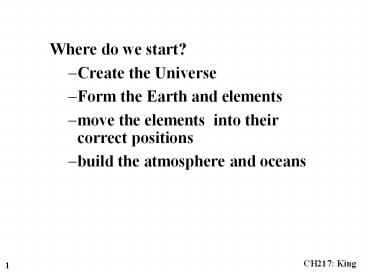Where do we start? - PowerPoint PPT Presentation
Title:
Where do we start?
Description:
Title: PowerPoint Presentation - Environmental Chemistry CH 217 Author: Whitney King Last modified by: Whitney King Created Date: 2/4/1998 9:42:53 AM – PowerPoint PPT presentation
Number of Views:27
Avg rating:3.0/5.0
Title: Where do we start?
1
- Where do we start?
- Create the Universe
- Form the Earth and elements
- move the elements into their correct positions
- build the atmosphere and oceans
2
The BIG BANG
- The Universe was created 15 billion years ago in
one BIG BANG ...... How do we know? - Start with the atom
3
ENERGY
Nucleus
4
ENERGY
E hv
Nucleus
5
(No Transcript)
6
Wavelength
700 nm
400 nm
Elemental Absorption
- Every element has a characteristic absorption
spectra - (ICP)
7
Spectrum of the Sun
http//images.encarta.msn.com/xrefmedia/aencmed/ta
rgets/illus/ilt/T014334A.gif
8
700 nm
Wavelength
- From the magnitude of the shift we can calculate
the speed of the star. - The more distant stars are moving the fastest.
- From distance and velocity information -gt TIME
15 billion years!
400 nm
9
At the Start
BANG
Protons and electrons
Big Blob of Neutrons (N)
12 Minutes
10
- Now we are COOKING ........... Fusion produces
heat - E mc2
- 1 gram of hydrogen will produce 6.3x1011 j of
heat. - Enough heat to boil 2 million liters of H2O
- Compare this to our terrestrial energy
consumption.
11
C
12
- This process stops at iron-56
13
Supernovae
Second Generation Star
Elements H-1 through Fe-56
H through Fe and n
Explosion
14
Supernovae
Second Generation Star
Elements H-1 through Fe-56
H through Fe and n
Explosion
15
(No Transcript)
16
Beta Decay
8
e-
14N
7
Proton Number
14C
6
5
6
7
8
9
Neutron Number
17
Electron Capture
20
e-
40K
19
Proton Number
40Ar
18
17
20
21
22
23
Neutron Number
18
Alpha Decay
147
238U
146
Proton Number
145
4He
234Th
144
143
89
90
91
92
93
Neutron Number
19
(No Transcript)
20
Review of Element Formation
- Big Bang
- Nuclear Cooking - Fusion
- Neutron Capture
- What is the end result?
21
(No Transcript)
22
(No Transcript)
23
(No Transcript)
24
What about the Earth?
25
Another look at the earth on a linear scale.
- Where did all the other elements go? H, He, C,
N?? - They got BLOWN AWAY
- This leaves just Si, Mg, Fe, and O
26
.....and just for fun
27
Formation of the Earth
- The earth started as a hot molten blob of metal
and oxygen - As the blob cooled, density differences of the
original components drove an elemental
segregation. - Metallic iron - The Earths core
- Mg, Fe, and Si oxides - The crust
- How do we know?
- We know from earthquake seismology
28
A Slice of the Earth
Inner Core
Outer Core
Mantle
29
A Slice of the Earth
Inner Core
2900 km
Outer Core
Mantle
- earthquakes travel as shear waves or
compressional waves
30
- shear waves only pass through SOLIDS (mantle)
- So we have a liquid iron core. This has
important implications for other elements - Ni, S, Au, Pt, Ag, Pb dissolve in the liquid
iron - What is left is Mg, Si oxide mantle.
- The mantle is not really solid, but really a
putty that is kept warm by the radioactive
decay of 40K, 235U, 238U, and 232Th. - The heating of the mantle drives convection cells.
31
Crust
Lower Mantle
Outer Core
Inner Core
- The mantle melt cycle (subduction/formation)
enriches the crust further in Si, Na, K, Ca, and
Al
32
What about the Oceans and the Atmosphere?
- The Earth is about 0.5 water. Where did it come
from? - The source of water in the early Earth is poorly
understood ...we are lucky that it arrived. - The gravitational attraction of the Earth
retained almost all of the water. - Surface water puts important constraints on
global temperature! 0 lt--gt 100 oC.
33
Controls on CO2
- CO2 is controlled by a global scale feedback loop
with a time scale of gt10,000 years - Consider the following reactions
34
Controls on CO2
- CO2 is controlled by a global scale feedback loop
with a time scale of gt10,000 years - Consider the following reactions
Generic Weathering Reaction
Generic Precipitation Reactions
Generic Mantle Reactions
35
Atmosphere
Oceanic Crust
Continental Crust
36
Lets work with units
CO2 (g) 0.0365 , This is a mixing
ratio O2 20.95 N2 78.08 Ar 0.93 PV nRT,
average mass gas 28.96 g/mol , 00/0, ppm,
ppb
37
Pressure
Atmospheric Pressure is a force kg/m2 P0
Mass(atm g)/4(pi)r2 r 6.37x106 m P0
101325 Pa Ph Po e -Mgh/RT
M 0.029 kg/mol R 8.314 J/mol K g 9.81
m/s2 Scale height 5-6 km
38
Unit Conversion































